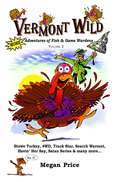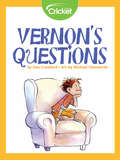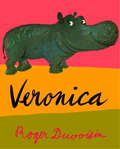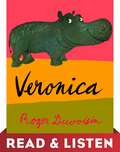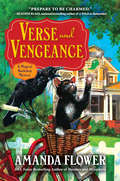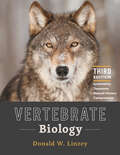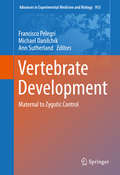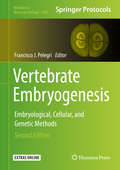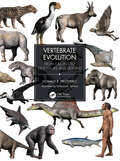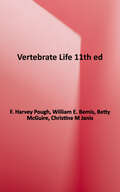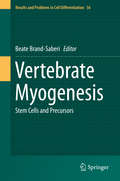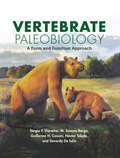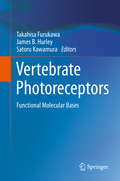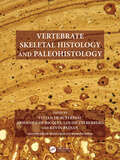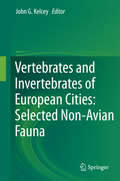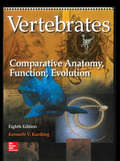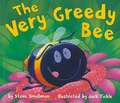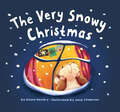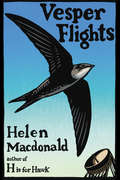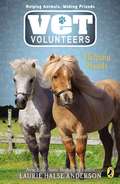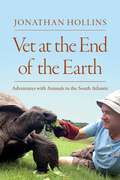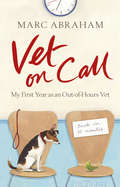- Table View
- List View
Vermont Wild: More Adventures of Fish and Game Wardens (Volume #2)
by Megan PriceMore hilarious, true game warden adventures. Laugh along as the officers set up a sting, confront cunning poachers, try to train a wily deputy dog, conduct searches and wrestle uncooperative critters. Loved by all ages.
Vernon's Questions
by Dan CrawfordTwo brothers take a seat in the living room to watch cartoons on TV, but find something more interesting out the window.
Veronica
by Roger DuvoisinVeronica, a hippopotamus who wants to stand out from the herd and be famous, travels to the big city where she indeed does stand out. Causing traffic jams, blocking sidewalks, and devouring a pushcart vendor's vegetables in one big gulp, Veronia is arrested and jailed. How she discovers that there is no place like home is told with warm humor and sublimely mirthful illustrations that are great fun to share with a young child.
Veronica: Read & Listen Edition
by Roger DuvoisinRead and listen along as Veronica, a hippopotamus who wants to stand out from the herd and be famous, travels to the big city where she indeed does stand out. Causing traffic jams, blocking sidewalks, and devouring a pushcart vendor&’s vegetables in one big gulp, Veronica is arrested and jailed. How she discovers that there is no place like home is told with warm humor and sublimely mirthful illustrations that are great fun to share with a young child.This ebook includes Read & Listen audio narration.
Verse and Vengeance: A Magical Bookshop Mystery (A Magical Bookshop Mystery #4)
by Amanda FlowerUSA Today bestselling author and Agatha Award winner Amanda Flower turns the charm up to ten in her fourth Magical Bookshop mystery.With the help of Walt Whitman's works, magical bookshop owner Violet Waverly puts her pedal to the metal to sleuth a bicycle-race murder that tests her mettle. A bicycle race is not Charming Books proprietor Violet Waverly's idea of a pleasant pastime. But police chief David Rainwater wheelie wants them to enter the Tour de Cascade as a couple, so she reluctantly consents. The Tour de Cascade is the brainchild of Violet's Grandma Daisy. The race is a fundraiser to build the Cascade Springs Underground Railroad Museum. But not everyone in this Niagara Region village supports the race. As if the bike race weren't tiring enough, pesky private investigator Joel Redding is snooping around Charming Books. It takes all of Violet's and Grandma Daisy's ingenuity to keep Redding from discovering the shop's magical essence--which communicates with Violet through books. When Redding perishes in an accident during the race, David discovers that the brake line of the private eye's bike was cut. Worse, Violet tops his list of suspects. As Emerson the tuxedo cat and resident crow Faulkner look on, Charming Books steers Violet to the works of Walt Whitman to solve the crime. But no other names ring a bell as culprits, and as David's investigation picks up speed, Violet will have to get in gear to clear her name.
Vertebrate Biology: Systematics, Taxonomy, Natural History, and Conservation
by Donald W. LinzeyThe most trusted and best-selling textbook on the diverse forms and fascinating lives of vertebrate animals.Covering crucial topics from morphology and behavior to ecology and zoogeography, Donald Linzey's popular textbook, Vertebrate Biology, has long been recognized as the most comprehensive and readable resource on vertebrates for students and educators. Thoroughly updated with the latest research, this new edition discusses taxa and topics such as• systematics and evolution• zoogeography, ecology, morphology, and reproduction• early chordates• fish, amphibians, reptiles (inclusive of birds), and mammals• population dynamics • movement and migration• behavior• study methods• extinction processes• conservation and managementFor the first time, 32 pages of color images bring these fascinating organisms to life. In addition, 5 entirely new chapters have been added to the book, which cover• restoration of endangered species• regulatory legislation affecting vertebrates• wildlife conservation in a modern world• climate change• contemporary wildlife managementComplete with review questions, updated references, appendixes, and a glossary of well over 300 terms, Vertebrate Biology is the ideal text for courses in zoology, vertebrate biology, vertebrate natural history, and general biology. Donald W. Linzey carefully builds theme upon theme, concept upon concept, as he walks students through a plethora of topics. Arranged logically to follow the most widely adopted course structure, this text will leave students with a full understanding of the unique structure, function, and living patterns of all vertebrates.
Vertebrate Development
by Francisco Pelegri Michael Danilchik Ann SutherlandThis book provides a comprehensive overview of topics describing the earliest steps of fertilization, from egg activation and fertilization to the activation of the zygotic genome, in various studied vertebrate model systems. The contribution of maternal and paternal factors and their role in the early embryo as parental DNA becomes modified and embryonic genes become activated is fundamental to the initiation of embryogenesis in all animal systems. It can be argued that this is a unique developmental period, when information from the parents is compressed to direct the development of the body plan of the entire organism, a process of astounding simplicity, elegance and beauty. In addition to their fundamental scientific interest, many frontiers of biomedicine, such as reproductive biology, stem cells and reprogramming, and the understanding of intergenerational diseases, depend on advances in our knowledge of these early processes. Vertebrate Development: Maternal to Zygotic Control brings together chapters from experts in various disciplines describing the latest advances related to this important developmental transition. Each chapter is a synthesis of knowledge relevant to all vertebrates, with details on specific systems as well as comparisons between the various studied vertebrate models. The editorial expertise encompasses the fields of major vertebrate model systems (mammalian, amphibian and teleost) ensuring a balanced approach to various topics. This unique book--with its combination of in-depth and up-to-date basic research, inter-species comprehensiveness and emphasis on the very early stages of animal development--is essential for research scientists studying vertebrate development, as well as being a valuable resource for college educators teaching advanced courses in developmental biology.
Vertebrate Embryogenesis: Embryological, Cellular, and Genetic Methods (Methods in Molecular Biology #1920)
by Francisco J. PelegriThis detailed volume explores animal embryogenesis in a way that aims to foster cross-model work and ideas by presenting methods that can be applied across laboratories and species boundaries. Improved protocols with updated advances in key traditional model systems are included, such as in amphibians, chicken, mouse, and zebrafish, as well as chapters on leopard gecko and the flexible-shelled slider turtle. Within these traditional model systems, new developments are presented, such as protocols for the analysis of cellular membranes and intracellular signals, light-controlled manipulation of function, and the analysis of transcriptomic and proteomic data in the context of the embryo. Written for the highly successful Methods in Molecular Biology series, chapters include introductions to their respective topics, lists of the necessary materials and reagents, step-by-step, readily reproducible laboratory protocols, and tips on troubleshooting and avoiding known pitfalls. Authoritative and fully updated, Vertebrate Embryogenesis: Embryological, Cellular, and Genetic Methods, Second Edition serves as an invaluable aid to scientists, educators, and the advanced general audience and will act as an inspiration to further our understanding and appreciation of animal development. Chapter 10, "Optogenetic Control of Subcellular Protein Location and Signalling in Vertebrate Embryos," is available open access under a Creative Commons Attribution 4.0 International License via link.springer.com.
Vertebrate Evolution: From Origins to Dinosaurs and Beyond
by Donald R. ProtheroThe first vertebrate animals appear in the fossil record over 520 million years ago. These lineages diversified and eventually crept ashore leading to further evolutionary divergence and the appearance of the familiar charismatic vertebrates of today. From the tiniest fishes, diminutive salamanders, and miniaturized lizards to gargantuan dinosaurs, enormous brontotheres, and immense whales, vertebrates have captured the imagination of the lay public as well as the most erudite academics. They are the among the best studied organisms. This book employs beautifully rendered illustrations of these diverse lineages along with informative text to document a rich evolutionary history. The prolific and best-selling author reveals much of the latest findings regarding the phylogenetic history of vertebrates without overwhelming the reader with pedantry and excessive jargon. Simultaneously, comprehensive and authoritative while being approachable and lucid, this book should appeal to both the scholar, the student, and the fossil enthusiast. Key Features Provides an up-to-date account of evolution of vertebrates Includes numerous beautiful color reconstructions of prehistoric vertebrates Describes extinct vertebrates and their evolutionary history Discusses and illustrates the first vertebrates, as well as familiar lineages of fishes, amphibians, reptiles, birds, and mammals Reviews mass extinctions and other important events in the diversification of vertebrates Related Titles Bard, J. Evolution: The Origins and Mechanisms of Diversity (ISBN 9780367357016) Böhmer, C., et al. Atlas of Terrestrial Mammal Limbs (ISBN 9781138705906) Diogo, R., et al. Muscles of Chordates: Development, Homologies, and Evolution (ISBN 9781138571167) Schweitzer, M. H., et al. Dinosaurs: How We Know What We Know (ISBN 9780367563813)
Vertebrate Life, Eleventh Edition
by Betty McGuire F. Harvey Pough William E. Bemis Christine M JanisWidely praised for its comprehensive coverage and exceptionally clear writing style, this best-selling text explores how animals' anatomy, physiology, ecology, and behavior interact to produce organisms that function effectively in their environments and how lineages of organisms change through evolutionary time.
Vertebrate Myogenesis
by Beate Brand-SaberiThis book addresses the differentiation control of skeletal muscle in different locations of the vertebrate body Particular attention is paid to novel regulatory molecules and signals as well as the heterogeneity of origin that have revealed a developmental overlap between skeletal and cardiac muscle. Different functional muscle groups are the product of the evolution of the vertebrate classes, making a phylogenetic comparison worthwhile for understanding the role of muscle stem cells and precursors in myogenesis. New insights into the hierarchy of transcription factors, particularly in the context of these different muscle groups have been gained from detailed investigations of the spatio-temporal and regulatory relationships derived from mouse and zebrafish genetics and avian microsurgery. Importantly, epigenetic mechanisms that have surfaced recently, in particular the role of MyomiRs, are also surveyed. With an eye to the human patient, encouraging results have been generated that identify parallels between embryonic myogenesis and regenerating myofibers due to common regulatory molecules. On the other hand, both processes differ considerably in quality and complexity of the processes employed. Interestingly, the heterogeneity in embryonic sources from which skeletal muscle groups in the vertebrate including the human body take origin is paralleled by differences in their susceptibility to particular muscle dystrophies as well as by the characteristics of the satellite cells involved in regeneration. The progress that has been made in the field of muscle stem cell biology, with special focus on the satellite cells, is outlined in this book by experts in the field. The authors review recent insights of the heterogeneous nature of these satellite cells regarding their gene signatures and regeneration potential. Furthermore, an improved understanding of muscle stem cells seems only possible when we study the impact of the cell environment on efficient stem cell replacement therapies for muscular dystrophies, putting embryological findings from different vertebrate classes and stem cell approaches into context.
Vertebrate Paleobiology: A Form and Function Approach (Life of the Past)
by Sergio F. Vizcaíno M. Susana Bargo Guillermo H. Cassini Néstor Toledo Gerardo De IuliisAn essential introduction to the paleobiology of animal body size, locomotion, and feeding.Paleobiology is the branch of evolutionary biology involved in the reconstruction of the life histories of extinct organisms. It answers the questions, How do we use fossils to reconstruct the size of prehistoric animals, and How did they move and feed? Drawing on a rich inventory of South American Miocene fossils, Vertebrate Paleobiology: A Form and Function Approach examines different aspects of functional morphology and how they are tested by paleontologists, anatomists, and zoologists. Beginning with a review of various methodologies to interpret fossils, the authors turn to the main concepts important to functional morphology and give examples of each. They conclude by showing how functional morphology enables a dynamic, broadscale reconstruction of the life of prehistoric animals during the South American Miocene.Originally published in Spanish, Vertebrate Paleobiology: A Form and Function Approach provides a broad sweep of recent developments, including theoretical and practical techniques, applied to the study of extinct vertebrates.
Vertebrate Photoreceptors
by Takahisa Furukawa James B. Hurley Satoru KawamuraThis book provides a series of comprehensive views on various important aspects of vertebrate photoreceptors. The vertebrate retina is a tissue that provides unique experimental advantages to neuroscientists. Photoreceptor neurons are abundant in this tissue and they are readily identifiable and easily isolated. These features make them an outstanding model for studying neuronal mechanisms of signal transduction, adaptation, synaptic transmission, development, differentiation, diseases and regeneration. Thanks to recent advances in genetic analysis, it also is possible to link biochemical and physiological investigations to understand the molecular mechanisms of vertebrate photoreceptors within a functioning retina in a living animal. Photoreceptors are the most deeply studied sensory receptor cells, but readers will find that many important questions remain. We still do not know how photoreceptors, visual pigments and their signaling pathways evolved, how they were generated and how they are maintained. This book will make clear what is known and what is not known. The chapters are selected from fields of studies that have contributed to a broad understanding of the birth, development, structure, function and death of photoreceptor neurons. The underlying common word in all of the chapters that is used to describe these mechanisms is "molecule". Only with this word can we understand how these highly specific neurons function and survive. It is challenging for even the foremost researchers to cover all aspects of the subject. Understanding photoreceptors from several different points of view that share a molecular perspective will provide readers with a useful interdisciplinary perspective.
Vertebrate Skeletal Histology and Paleohistology
by Kevin Padian Michel Laurin Louise Zylberberg Vivian De Buffrénil Armand J. de Ricqlès Alexandra QuilhacVertebrate Skeletal Histology and Paleohistology summarizes decades of research into the biology and biological meaning of hard tissues, in both living and extinct vertebrates. In addition to outlining anatomical diversity, it provides fundamental phylogenetic and evolutionary contexts for interpretation. An international team of leading authorities review the impact of ontogeny, mechanics, and environment in relation to bone and dental tissues. Synthesizing current advances in the biological problems of growth, metabolism, evolution, ecology, and behavior, this comprehensive and authoritative volume is built upon a foundation of concepts and technology generated over the past fifty years.
Vertebrate Taphonomy
by R. Lee LymanTaphonomy studies the transition of organic matter from the biosphere into the geological record. It is particularly relevant to zooarchaeologists and paleobiologists, who analyse organic remains in the archaeological record in an attempt to reconstruct hominid subsistence patterns and paleoecological conditions. In this user-friendly, encyclopedic reference volume for students and professionals, R. Lee Lyman, a leading researcher in taphonomy, reviews the wide range of analytical techniques used to solve particular zooarchaeological problems, illustrating these in most cases with appropriate examples. He also covers the history of taphonomic research and its philosophical underpinnings. Logically organised and clearly written, the book is an important update on all previous publications on archaeological faunal remains.
Vertebrates and Invertebrates of European Cities:Selected Non-Avian Fauna
by John G. KelceyVertebrates and Invertebrates of European Cities: Selected Non-Avian Fauna is the first known account of the vertebrate and invertebrate fauna of several cities in Europe and throughout the rest of the world. It excludes birds, which are described in a companion volume. The book contains eleven chapters about nine cities distributed throughout Europe. The chapters start with the history of the cities, which is followed by a description of the abiotic features such as geology, climate, air and water quality and then a brief account of the habitats. The vertebrate chapters describe the fish, amphibians, reptiles and mammals that are known to occur in each city together with their status and the habitats in which they occur, for example housing, industrial areas, parks, transport routes and rivers. The invertebrate chapters contain an account of the presence, status and habitats occupied by 6 - 8 of the major invertebrate groups including butterflies, dragonflies and damselflies, crickets and grasshoppers, beetles, molluscs, spiders, mites and springtails. This volume has been written and edited to be accessible to a wide range of interests and expertise including academic biologists, urban ecologists, landscape architects, planners, urban designers, undergraduates, other students and people with a general interest in natural history (especially cities) - not only in Europe but throughout the world.
Vertebrates: Comparative Anatomy, Function, Evolution (8th Edition)
by Kenneth V. KardongThis one-semester text is designed for an upper-level majors course. Vertebrates features a unique emphasis on function and evolution of vertebrates, complete anatomical detail, and excellent pedagogy. Vertebrate groups are organized phylogenetically, and their systems discussed within such a context. Morphology is foremost, but the author has developed and integrated an understanding of function and evolution into the discussion of anatomy of the various systems.
Very Greedy Bee
by Steve SmallmanMINE! That's what the very greed bee says to anyone who asks him to share. While all the other bees work hard to clean the hive and make honey, they very greedy bee spends all of his time gobbling pollen and guzzling nectar. <P><P>One day he finds a meadow full of flowers and decides not to tell anyone. He spends the entire day buzzing from flower to flower until. . . THUMP. The very greedy bee is so full that he cannot fly! It's getting dark and he doesn't know how to get home unless he flies. With the help of some new found friends the very greed bee is able to return to his hive and has learned that it's best to work with others and share what you have.
Very Hairy Bear
by Alice SchertleAll through the year, this shaggy, raggy, rumbly, bumbly bear faces down whatever comes his way: bee stings and scolding squirrels, cold rushing rivers and prickly bushes. And he does it all with a spring in his step and a smile on his face. There's just one thing he can't abide. Luckily, he knows exactly what to do about it. Season by season, Alice Schertle and Matt Phelan lead us through a year in the life of a charming, resourceful, and quite hairy bear.
Very Snowy Christmas
by Diane HendryAfter searching for perfect holly with shiny berries to decorate his Christmas tree Little Mouse begins to make his way home. Suddenly soft white flakes begin falling all around him. "The sky is coming apart!" fears Little Mouse. But Big Mouse shows Little Mouse that snow isn't scary at all. In fact, it's magical!
Vesper Flights
by Helen MacdonaldFrom the bestselling author of H is for Hawk, a brilliant and insightful work about our relationship to the natural worldOur world is a fascinating place, teeming not only with natural wonders that defy description, but complex interactions that create layers of meaning. <P><P>Helen Macdonald is gifted with a special lens that seems to peer right through it all, and she shares her insights--at times startling, nostalgic, weighty, or simply entertaining--in this masterful collection of essays. From reflections on science fiction to the true story of an Iranian refugee's flight to the UK, Macdonald has a truly omnivorous taste when it comes to observations of both the banal and sublime. <P><P>Peppered throughout are reminisces of her own life, from her strange childhood in an estate owned by the Theosophical Society to watching total eclipses of the sun, visits to Uzbek solar power plants, eccentric English country shows, and desert hunting camps in the Gulf States. These essays move from personal experiences into wider meditations about love and loss and how we build the world around us. Whether more journalistic in tone, or literary--even formally experimental--each piece is generous, lyrical, and speaks to one another. <P><P>Macdonald creates a strong thematic undertow that quietly takes the reader along piece to piece and sets them down, finally, at a place they've never been before. <P><P><b>A New York Times Bestseller</b>
Vet Confidential: An Insider's Guide to Protecting Your Pet's Health
by Louise MurrayA comprehensive, must-have guide for ensuring high-quality care for pets, "Vet Confidential" offers pet owners everything they need to know about keeping their pets healthy, and tells who they can safely trust with their pets' health.
Vet Volunteers 15 Helping Hands
by Laurie Halse AndersonJules and Josh are so excited when their parents hire ponies to attract customers to their sidewalk sale. But the Vet Volunteers notice that the ponies don't seem to be very healthy, and after an examination, they learn that the handler, Gus, has been mistreating them. Can the Vet Volunteers help the ponies get well and find a better life for them?
Vet at the End of the Earth: Adventures with Animals in the South Atlantic
by Jonathan HollinsThe passionate story of a vet&’s care for all creatures great and small in the colorful, diverse, and distinctive South Atlantic islands.The role of a resident vet in the remote islands of the Falklands, St. Helena, Ascension, and Tristan da Cunha encompasses many wonderful complexities: caring for the world&’s oldest living land animal (a 200-year-old giant tortoise, denizen of the St. Helena governor&’s lawn); pursuing mystery creatures and invasive microorganisms; relocating herds of reindeer; and rescuing animals in extraordinarily rugged landscapes, from subtropical cloud forests to volcanic cliff faces. Hugely entertaining and affectionate, Jonathan Hollins&’s tales of island vet life are not only full of ingenuity and astounding fauna—they are also steeped in the unique local cultures, history, and peoples of the islands, far from the hustle of continental life. Come join Jonathan on his daily adventures with these alluring and fascinating creatures.
Vet on Call: My First Year as an Out-of-Hours Vet
by Marc AbrahamWhen his father sat him down and told him to 'make something' of himself, young vet Marc Abraham decided to do it the hard way - by setting up an emergency 'out of hours' clinic. If getting used to the long night shifts wasn't bad enough, emergency cases are rarely straightforward. Whether it was dog who swallowed golf balls, or a gerbil in urgent need of a caesarean, every case had the potential for heartbreak. But animals and their owners could also be hilarious, such as the breeder who unwittingly gave his German Shepherd four testicles. . .Over the course of twelve tough months, the clinic began to flourish. Would Marc finally make something of himself after all?Marc Abraham writes guilelessly about his early mistakes, and the terror and joy involved in saving an animal's life. His memoir is a heart-warming, compelling and thoroughly entertaining look at the life of a vet on call.
